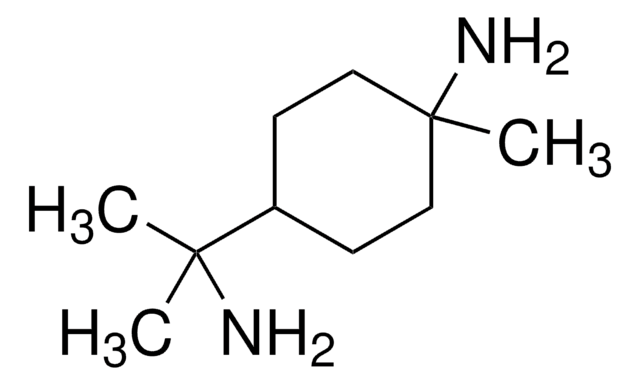全部照片(2)
About This Item
線性公式:
CH3CH2CH(NH2)CH2CH2NH2
CAS號碼:
分子量::
102.18
Beilstein:
6796726
MDL號碼:
分類程式碼代碼:
12162002
PubChem物質ID:
NACRES:
NA.23
推薦產品
化驗
98%
折射率
n20/D 1.452 (lit.)
bp
164 °C (lit.)
mp
−121 °C (lit.)
密度
0.855 g/mL at 25 °C (lit.)
SMILES 字串
CCC(N)CCN
InChI
1S/C5H14N2/c1-2-5(7)3-4-6/h5H,2-4,6-7H2,1H3
InChI 密鑰
WTSXICLFTPPDTL-UHFFFAOYSA-N
尋找類似的產品? 前往 產品比較指南
法律資訊
DYTEK is a registered trademark of Invista North America S.a.r.l.
訊號詞
Danger
危險聲明
危險分類
Flam. Liq. 3 - Skin Corr. 1B
儲存類別代碼
3 - Flammable liquids
水污染物質分類(WGK)
WGK 3
閃點(°F)
138.2 °F - closed cup
閃點(°C)
59 °C - closed cup
個人防護裝備
Faceshields, Gloves, Goggles, type ABEK (EN14387) respirator filter
客戶也查看了
Stephany Y Tzeng et al.
International journal of nanomedicine, 6, 3309-3322 (2012-01-10)
Biodegradable poly(ester amine) (PEA)-based and poly(amido amine) (PAA)-based nanoparticles were developed for efficient in vitro siRNA delivery to human umbilical vein endothelial cells (HUVECs). They were screened, characterized, and compared with traditionally studied DNA-containing particles. Several of the polymeric nanoparticles
Camila G Zamboni et al.
Journal of controlled release : official journal of the Controlled Release Society, 263, 18-28 (2017-03-30)
Hepatocellular carcinoma (HCC) is the third most deadly cancer in the US, with a meager 5-year survival rate of <20%. Such unfavorable numbers are closely related to the heterogeneity of the disease and the unsatisfactory therapies currently used to manage
Antonella Mangraviti et al.
ACS nano, 9(2), 1236-1249 (2015-02-03)
Biodegradable polymeric nanoparticles have the potential to be safer alternatives to viruses for gene delivery; however, their use has been limited by poor efficacy in vivo. In this work, we synthesize and characterize polymeric gene delivery nanoparticles and evaluate their
Jieun Hong et al.
Journal of controlled release : official journal of the Controlled Release Society, 200, 212-221 (2015-01-03)
Lineage conversion from one somatic cell type to another is an attractive approach for deriving specific therapeutic cell generation. In order to bypass inducing pluripotent stage, transdifferentiation/direct conversion technologies have been recently developed. We report the development of a direct
Feng Zhu et al.
ACS nano, 9(3), 2948-2959 (2015-02-11)
Organometallic halide perovskites CH3NH3PbX3 (X = I, Br, Cl) have quickly become one of the most promising semiconductors for solar cells, with photovoltaics made of these materials reaching power conversion efficiencies of near 20%. Improving our ability to harness the
我們的科學家團隊在所有研究領域都有豐富的經驗,包括生命科學、材料科學、化學合成、色譜、分析等.
聯絡技術服務















